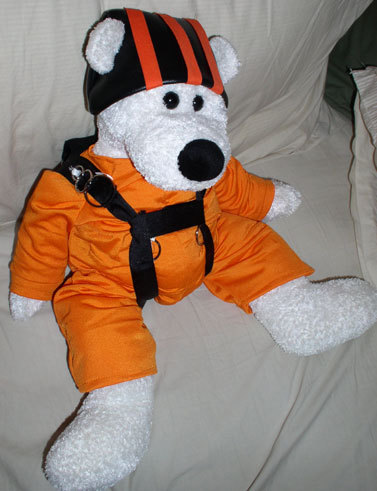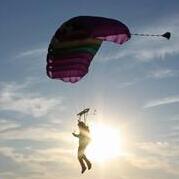Recommended Posts
winsor 236
QuoteI assume I might have lost altitude awareness by asking myself "do i need to pull my reserve now"
every time I look at my altimeter.
If the needle is in the action area: "pull reserve" on my altimeter my plan is to pull reserve.
After I started training this mentally in different ways, I have been low once and I went straight for reserve.
I think the hardest part of the mental training for this emergency procedure is for my ego to honestly believe in the scary thought that I could have fucked up.but at least this part get easier the more jumps and more mistakes I make.
When you're in the basement, an altimeter is no longer of much use. Ground rush becomes the dominant reality, and making high-level decisions may take more time than you have.
If you ever see the ground getting visibly closer FAST, it is imperative that you get something overhead immediately. I do practice pulls three or four times per jump, but I have only yanked silver six times for real. OTOH, I have deployed BOC throwout and PUD thousands of times, and can do so instantly. I don't jump anything that snivels in particular, and the amount of altitude burned up going for the reserve is easily greater than the difference between main and reserve opening distances.
About the only time my game plan involves using the reserve when low is if the plane breaks right after takeoff. Below my cutoff altitude - which varies upon the main in use (EXTreme 99 FX or Raven IV?)and the venue (Eloy AZ or Lebanon ME?) - the plan is to unass the aircraft most rapidly (as instructed by the pilot - and I *have* been told "GET OUT OF MY AIRPLANE!" when one quit working) and pull the reserve when clear of the tail.
Above the cutoff altitude, I go to the main as expected. If we're high enough, we turn points after the emergency exit (hey, altitude is altitude...).
Blue skies,
Winsor
Quote
Above the cutoff altitude, I go to the main as expected. If we're high enough, we turn points after the emergency exit (hey, altitude is altitude...).
I heard about a C182 emergency, jumpers were told to get out so they launched a 4 way. On another emergency when a loud bang was heard coming from the engine the pilot turned to call 'aircraft emercency' (another C182) only to see the last pair of heels disappearing out of the door.
Get out, Land on a green bit. If you get the pull somewhere in between it would help.
op5e 0
QuoteAbove the cutoff altitude, I go to the main as expected. If we're high enough, we turn points after the emergency exit (hey, altitude is altitude...).
That is the funniest thing I've read all week.
Great thread.
In a world full of people, only some want to fly, is that not crazy?
http://www.ukskydiver.co.uk
Zoter 0
In a weekend of jumps....I make a point of on at least 1 jump, when flipping over to pull....spend a sec and just touch all those handles in the order you would pull em' (in freefall)....
It just keeps your 'stability' current when reaching for 'unusual stuff'
But I have the fastest deployed reserve in the world....why should I care
BTW my dytter/protrack tones have gone off at some funny times on a jump and under a deploying canopy.....they are a guide only.....I reckon your first thought on hearing them is to look straight down or at that alti!!
billvon 3,173
> myself) what would you suggest to be the answer. Mine would be to
> turn, arch and pull reserve.
My advice to you would be to ignore the turn and arch parts and open whatever parachute you can get to the fastest. It's probably your main. A main opening at 1500 feet isn't the end of the world, but turning, arching, then opening your reserve after spending a few seconds looking for it (it's likely you've never pulled it in freefall before) could put you dangerously low.
Other options - remember, you can turn even after you pull. If you pull and then turn, it's likely your parachute will turn somewhat as well, thus reducing your odds of a collision. Although the risk of collision isn't a big one, since if everyone else on your 4-way was happily turning points, it's going to take half a second for them to realize what it means that you just pulled. By that time you'll be decelerating away from them.
If you like the answer "go for reserve" then make sure you practice it. Jump, let yourself get a bit low (not below your normal deployment altitude, of course) then practice finding and pulling your reserve. Don't actually pull it - just make sure you can find it and get your hands on it. The important part here is to train so that it's automatic if it ever happens to you. You can't afford time to think about it when you're getting close to 1000 feet.
QuoteAlthough the risk of collision isn't a big one, since if everyone else on your 4-way was happily turning points, it's going to take half a second for them to realize what it means that you just pulled. By that time you'll be decelerating away from them.
And there is a real good chance you will be a little short of team members on the your next jump.
Sparky
BASE813 0
Although you may say "i will go for reserve" - your instinct kicks in to do the 1 thing that you have done hundreds of times before to save your life - pitch your PC...............
billvon 3,173
I'd have to disagree with that. I know a few students who didn't do a damn thing, and were saved by their cypres when they didn't open their main or failed to respond to a malfunction. They did not choose the right action.
It's great when someone survives their mistakes, but that doesn't make them non-mistakes. It makes them lucky.


.thumb.jpg.4bb795e2eaf21b8b300039a5e1ec7f92.jpg)


every time I look at my altimeter.
If the needle is in the action area: "pull reserve" on my altimeter my plan is to pull reserve.
After I started training this mentally in different ways, I have been low once and I went straight for reserve.
I think the hardest part of the mental training for this emergency procedure is for my ego to honestly believe in the scary thought that I could have fucked up.
-- "If you can dream it, you can DO IT!" --
Share this post
Link to post
Share on other sites